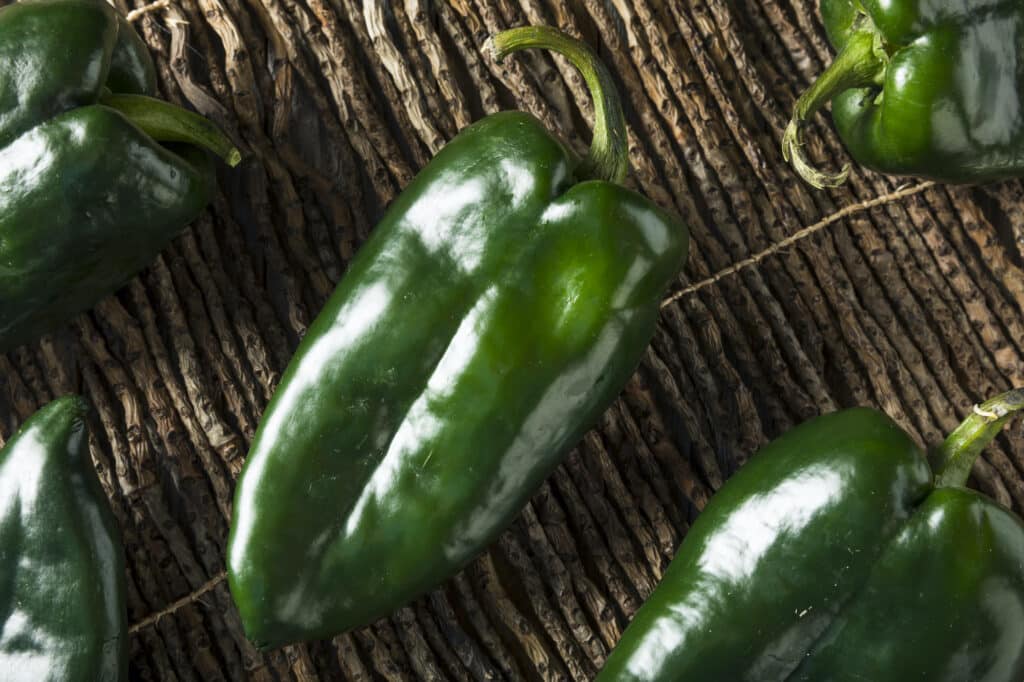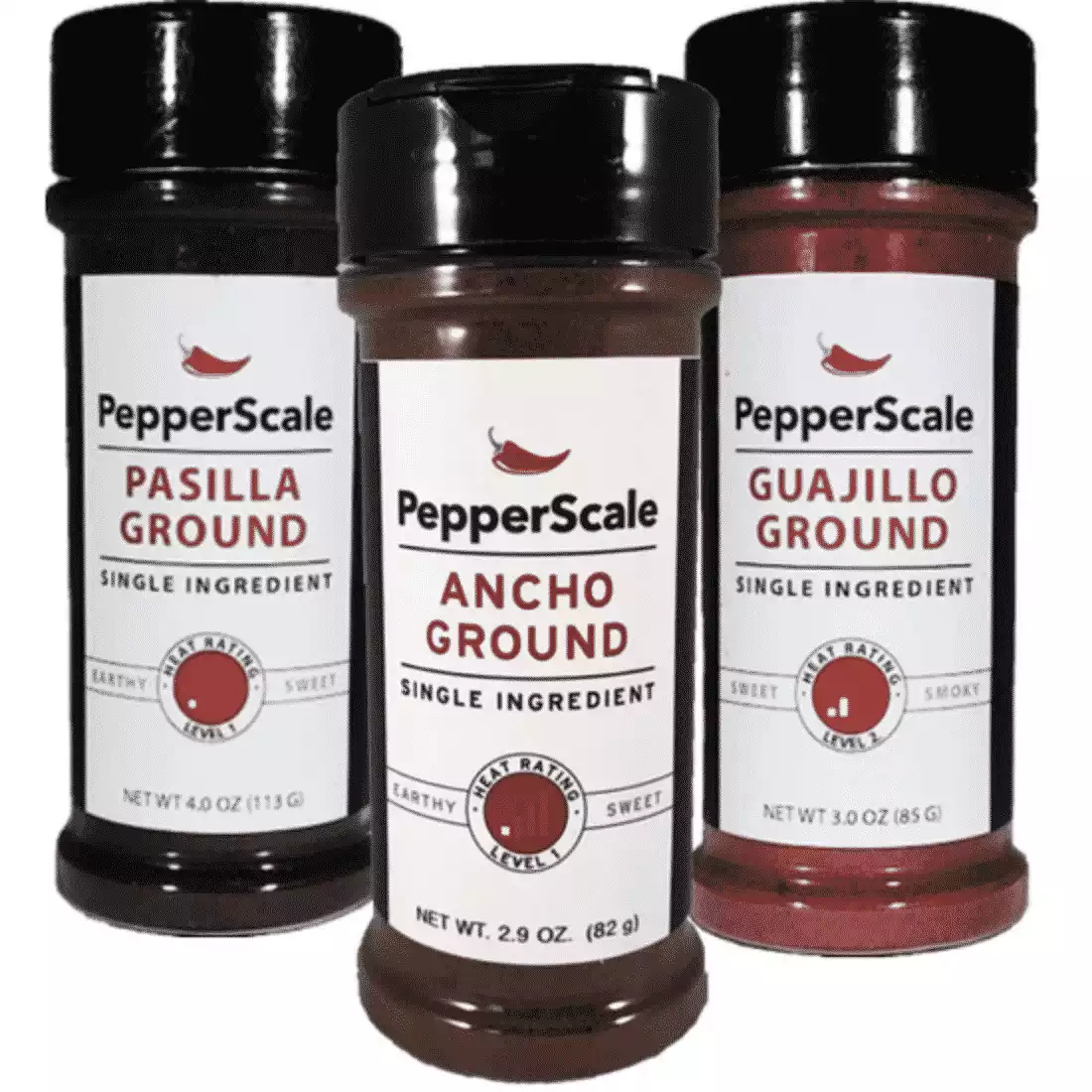Poblano peppers and bell peppers are both incredibly popular and easy to find. They are both staples for North American cooking and Mexican dishes, but how do they truly differ? How much hotter is a poblano, really, from a bell? And how different is their flavor? Let’s compare.
Table of Contents
- Quick Comparison: Poblano Vs. Bell
- How much hotter is a poblano than a bell pepper?
- Which is more popular?
- How does each pepper taste?
- How do their shapes and colors differ?
- Where did each pepper originate?
- Which is easier to find fresh?
- Which is used more in commercial products?
- Must-read related posts
Quick Comparison: Poblano Vs. Bell
| Poblano | Bell | |
| Scoville heat units (SHU) | 1,000 – 1,5000 | 0 |
| Median heat (SHU) | 1,250 | 0 |
| Jalapeño reference point | 2 to 8 times milder | No heat |
| Species | Capsicum Annuum | Capsicum Annuum |
| Origin | Mexico | Mexico, Central America |
| Use | Culinary | Culinary |
| Size | Approximately 4 inches long; broad | Approximately 4 to 5 inches long, broad |
| Flavor | Earthy | Bright, Sweet |
How much hotter is a poblano than a bell pepper?
As sweet peppers, bell peppers have no heat, so any chili will taste hotter than it. Poblanos are truly not that much higher on the Scoville scale than bells. Poblano peppers have a mild heat, ranging from 1,000 to 1,500 Scoville heat units (SHU.) Often, poblanos have more of a warmth to them than true spiciness.
Poblanos sit in a similar range (though, a narrower band) as Anaheim peppers (500 to 2,500 SHU.) And they are much milder than jalapeño peppers, which range from 2,500 to 8,000 SHU. (a low-medium heat level.) Poblanos are a far cry from upper-medium heat level chilies like the cayenne pepper (30,000 to 50,000 SHU) and far away from the hottest peppers in the world, which can eclipse 1,000,000 SHU.
Which is more popular?
Let’s compare these peppers by how often they are globally searched for online. Both are popular, but the bell far exceeds the poblano. “Bell pepper” and variants are search 250,000+ times monthly, while “poblano pepper” and variants are searched roughly 150,000+ times monthly.
How does each pepper taste?
The thick walls of poblano chilies make them crunchy when very fresh. Green poblanos have a bright, grassy flavor (like green bell peppers) but with a little added earthiness and bitterness. While poblanos are typically sold green in supermarkets, you can come across mature red poblanos – and they have a little additional sweetness to them. Most chilies gain in sweetness as they ripen (and change color) on the vine.
Bell peppers have thicker, fleshier walls than those of poblanos. With a green bell pepper, you will get some of the bright grassiness from the poblano, but the flavor is not as intense. When they are ripe, bell peppers are sweeter and fruitier than poblanos.
Note: The skin of the poblano has a waxy texture to it. While it doesn’t impact its flavor, it does impact its mouthfeel. Some don’t mind it, others do.


How do their shapes and colors differ?
Poblanos and bell peppers are two of the larger pepper varieties. Poblanos measure about four inches long and about two inches in diameter. They have a broad top and narrow to a point. While unripe, poblanos are a medium to dark green and their skin is very glossy.
Poblanos ripen to a bright red, but you’ll typically find fresh green poblano peppers sold in stores. In their mature red form, most poblanos are dried and take on a different name: ancho peppers. As anchos, these chilies take on a smoky flavor. The ancho is one of the most popular Mexican chili peppers in its own right. It’s part of the holy trinity of chilies renowned for making authentic Mexican mole.
Our "Holy Trinity" pack features three dried chilies often featured in mole sauces: ancho (earthy and sweet, 1,000 to 1,500 Scoville heat units), pasilla (earthy and sweet, 1,000 to 2,500 SHU), and guajillo (sweet and smoky, 2,500 to 5,000 SHU). It's a great mild to low-medium combo of ground chilies!
Bell peppers typically measure between four and five inches long, with a diameter of between two and three inches wide. Bell peppers also have glossy skin, but not the waxy texture of the poblano’s skin. Bells have lobed and dimpled ends instead of the pointy ends that you see on poblanos; the lobes give the pepper a vague bell shape, which accounts for its name.
Bells are often sold green, but they can ripen to a range of colors with the most common being red but there are also white, yellow, and even purple varieties.
–> Learn More: Why Do Bell Peppers Come In So Many Colors?
Where did each pepper originate?
Poblanos chilies are believed to be among the first peppers eaten by natives in what is now Mexico. The name indicates that the peppers most likely came from the state of Puebla in east-central Mexico. The poblano is named for the state, poblano being the word for people from Puebla. The poblano chili has continued to be one of the main peppers in the Mexican diet.
Fossil evidence shows that bell peppers have been cultivated for thousands of years. One theory posits that mild peppers like the bell originated in Central America — southern Mexico in particular — as opposed to hot peppers that are believed to come from South America. Bell peppers were taken to Europe from the New World by Spanish and Portuguese colonists and now are cultivated in many parts of the world. China and Mexico are the world’s top two producers of bell peppers today.
Which is easier to find fresh?
While both are very common, the bell is a staple pepper that you’ll find in nearly every supermarket in the world. Poblanos are available year-round in most North American grocery stores and a staple in Mexico as it’s one of the staple chilies for Mexican cuisine.
Which is used more in commercial products?
Poblanos show up in more commercial products, including hot sauces, salsa, and frozen prepared meals. Bell peppers are available dried and canned but those products are not as common as the ones with poblanos.
Must-read related posts
- Mexican Peppers Guide: From ancho chilies to serrano peppers and more.
- Ancho Vs. Pasilla Pepper: How do these two dried chilies compare?
- The Hot Pepper List: We profile 150+ types of peppers – search our list by name, heat level, flavor, origin, and more.
